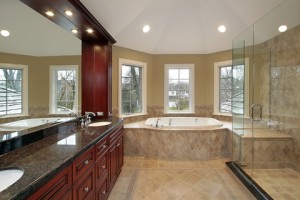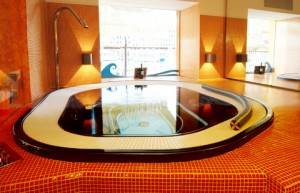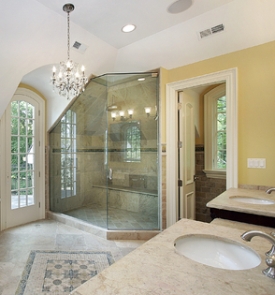Bathroom Lighting Design: Ideas for Tasks, Accents and Features
Bathroom lighting design is one of the most challenging and exciting projects in the home. It requires a balance of the right light for tasks with the right mood.
Bathroom lighting design provides some of the most difficult and rewarding challenges of any home lighting. Bright task lighting around the mirror area, a desire for creating a relaxing mood and safety limitations all pull lighting design in different directions. However, there are a number of great ways to provide a comfortable, well-lit space that is both useful and attractive. The goal is to ensure that there is sufficient lighting available for all household tasks, while still creating a warm and welcoming mood.
With lighting properly arranged, the bathroom can become both a functional and attractive space that will comfort you and impress your guests. On this page, I will go through the various areas of the bathroom and what should be taken into consideration in lighting each of them.
Vanity Lighting
Vanity lighting is perhaps the trickiest part of bathroom lighting design (if not the trickiest part of home lighting design). Properly lighting the sink and mirror area requires attention to all of the following, so that they can function well when applying makeup or shaving.
- Sufficient brightness for safety and accuracy. You need to ensure that the light is good enough for both shaving and putting on makeup.
- Correct color for rendering makeup. You want bulbs that match the lighting where you will be going, using warmer-colored light for evening makeup and whiter-colored lighting for daytime makeup.
- Minimal glare for comfort. Shining light on the face without shining it in the eyes is one of the hardest parts of vanity lighting.
- Correct angle of the light to prevent dark shadows. Lights directly over the sink cast deep shadows inaccurately accentuate wrinkles.
- Safety due to proximity of lighting to water. Bathroom lighting has special requirements, so consult with an electrician.
This, of course, is a lot to consider when lighting the mirror and sink. However, taking the above as a checklist and ensuring them one-by-one makes it much easier.
Bathtub Lighting
In bathroom lighting design, bathtub lighting fixtures are almost the opposite of vanity lighting. While vanity lighting seeks to provide as much information while interfering with the rest of room as little as possible, bathtub lighting seeks to provide as much comfort as possible while being interfered with by the rest of the room as little as possible.
The fundamental goal of bathtub lighting is comfort. To that end, there are a number of different things you should make sure of in bathtub lighting:- The light should be dim or diffuse. In other words, try to avoid strong, bright lights that cause a lot of reflection or strong shadows.
- The light should be warm. By warm, I mean lights that are on the red end of the spectrum, such as incandescent or candle light. This accentuates skin tones.
- There should be no glare. Many people put downward shining lights directly over their bathtubs. This is a terrible mistake, as it makes it uncomfortable to open your eyes while leaning backwards.
- It should be safe. Safety is even more of a concern in the bathtub than at the sink because someone immersed in water is in even more danger of electrocution.
You’ll notice, of course, that these considerations are, in many cases, exactly the opposite of those suggestions concerning vanity lighting, which brings me to my final point:
- The light at the bathtub should be insulated as much as possible from the vanity light.
Again, considering all of the above as a checklist makes lighting the bathtub easy and will provide you with a comfortable bathing space.
Shower Lighting
Shower lighting is, in many ways, the easiest part of bathroom lighting design. The space is naturally insulated from the rest of the room by a curtain or glass door, and showers are generally considered more “functional” than the rest of the bathroom.
There are a lot of exciting things that you can do with shower lighting, however, provided that you ensure that safety rules are met (safety rules in showers are much stricter than in the rest of bathroom lighting design, since your fixtures are actually intended to get wet):- One common option is to have a single, downward-shining light that illuminates the entire shower area. Since you will rarely be seen in the shower, the usual concern about harsh shadows don’t apply.
- A more exciting option, however, is to have the lighting shining upward into the shower. This has the interesting effect of actually illuminating the drops of water as they pass by.
- Finally, you can mostly rely on lighting from outside the shower. Using a clear glass door or a slightly frosted one will enable your light to mostly come in from outside.
You may, of course, choose more than one of the above options. How the shower is lit depends more on the overall style of the home. Uplights tend to be more common in modern bathroom lighting, while downlighting tends to be more popular for those looking for a well-lit, but not ostentatious shower. A complete lack of lighting should really only be used if the rest of your bathroom lighting design is very bright, but external lighting can still complement internal shower light.
Ceiling and Wall Fixtures
Of course, bathroom lighting design is not simply about the design in specific areas, but about the bathroom as a whole. The ceiling and wall fixtures should provide your bathroom with overall ambient lighting and mood, rather than having it seem like it is just a few separate functional areas.
For the most part, there are a number of different types of lighting that should be avoided in a bathroom. Any fixture where the wires or electified parts (like lamps or track lighting) should, in general, be avoided. They are simply too much of a safety hazard. Before putting any form of lighting into a bathroom, you should always consult with an electrician.What is left, then are covered, built-lights as well as recessed lighting. Often, people are hesitant about built-in lighting because it is so difficult to change. However, for bathrooms, this is different, as your bathroom plumbing fixtures won’t be moving either. So, built-in lighting is less of a risk in bathroom lighting design than elsewhere.
Bathroom ceiling lighting can be used in different ways:
- It can be used to light sinks, baths and showers, provided they are not directly over the sink or over the head area in the bath.
- It can provide central lighting for the entire room, augmenting the task lighting in the other areas. This can either be done centrally or through the use of recessed lighting.
Wall lighting, including bathroom wall sconces, similarly, have a number of functions:
- It can be used to light people’s faces at the mirror, though it is important to be careful of glare.
- It can provide uplighting over a tub, balancing the light overall in the bathroom, while providing diffuse light for bathing.
- It can provide ambient lighting for the entire bathroom.
Ceiling and wall fixtures, then, can be used both to contribute to the lighting of the different functional areas of the bathroom, or they can be used to light the bathroom itself as a whole.
More Bathroom Lighting Design Articles:
Bathroom Vanity Lighting: Choose and Position Lights and Light Fixtures
Bathroom vanity lighting is a challenge for anyone trying to create attractive, comfortable and useful lighting. Fortunately, it is all a matter of finding the right position and brightness.
Bathroom Ceiling Lighting: Using Ceiling Light to Create Warmth and Comfort
Bathroom ceiling lighting can make your entire bathroom more comfortable.
Modern Bathroom Lighting: Adjusting Lights to Contemporary Design
Modern bathroom lighting design adapts to changes in contemporary bathroom styles.
Bathroom Wall Sconces: Flattering and Practical Fixtures
Bathroom wall sconces can contribute both to vanity lighting and a bathroom’s overall lighting plan.
Bath Lighting Fixtures: Relaxation and Luxury
Bath lighting fixtures allow you to make bathing relaxing and luxurious.



